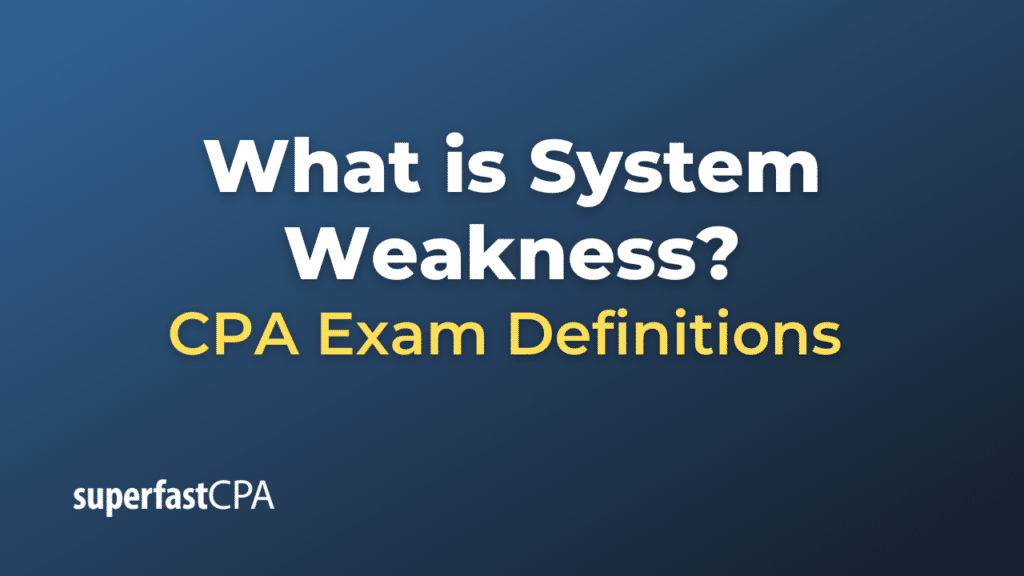System Weakness
A “system weakness” refers to any limitation, flaw, vulnerability, or deficiency in a system that can impede its ability to achieve its intended purpose or function reliably and securely. “System” here can refer to a variety of setups, including information systems, computer networks, software applications, business processes, or even physical systems like machinery.
In the context of information technology and cybersecurity, a system weakness often pertains to vulnerabilities in software, hardware, or procedures that can be exploited by malicious actors to gain unauthorized access, disrupt operations, steal information, or cause other harm.
System weaknesses can arise due to:
- Software Bugs: Coding errors or oversights that cause software to behave unexpectedly or insecurely.
- Outdated Systems: Using outdated software or hardware that lacks recent security patches or has known vulnerabilities.
- Poor Configuration: Improper setup or default configurations of software, hardware, or network devices that leave them vulnerable.
- Lack of Protective Measures: Absence of firewalls, antivirus software, intrusion detection systems, etc.
- Weak Authentication Mechanisms: Use of easily guessable passwords, lack of multi-factor authentication, etc.
- Operational Procedures: Inefficient or lack of procedures for things like data backup, system monitoring, or incident response.
- Physical Vulnerabilities: Lack of secure physical access controls to devices or servers, which could allow unauthorized individuals to access or tamper with them.
Example of System Weakness
Let’s illustrate the concept of “system weakness” with a detailed example:
Scenario: MedHealth Hospital’s Patient Data System
Background: MedHealth Hospital uses an online system where doctors and nurses can access patient records. The hospital prides itself on using advanced technology to provide swift and effective care. However, the system was developed a decade ago and has not been updated since.
System Weaknesses:
- Outdated Software: The system operates on a version of software that hasn’t been updated in years. Known vulnerabilities in this software version make the system susceptible to certain cyber-attacks.
- Weak Password Requirements: The system only requires a 4-character password for access. Many staff members use easy-to-guess passwords like “1234” or “abcd.”
- Lack of Encryption: Patient records are stored without any encryption, meaning that if someone could gain access, they would immediately have readable patient data at their disposal.
- Unmonitored Access Logs: There’s no system in place to alert administrators of unusual access patterns. A nurse accessing hundreds of patient records in a short span might go unnoticed.
- Physical Vulnerabilities: The servers hosting the patient data system are located in a room that’s occasionally left unlocked, allowing unauthorized personnel the opportunity to tamper with the hardware.
Incident:
A malicious actor, aware of the system’s vulnerabilities, launches a cyber-attack targeting the hospital’s patient data system. Using a known exploit in the outdated software, the attacker gains access. Given the weak password requirements, they easily guess passwords for several accounts. The attacker downloads thousands of unencrypted patient records.
Aftermath:
Once discovered, the breach results in significant consequences for MedHealth Hospital:
- Reputation Damage: Patients lose trust in the hospital’s ability to safeguard their personal and medical information.
- Financial Impact: The hospital faces potential lawsuits and penalties for the data breach.
- Operational Disruption: The hospital needs to shut down the system temporarily to address the breach, disrupting regular operations.
Resolution:
To address these weaknesses:
- The hospital upgrades its software to the latest version.
- Password requirements are strengthened, and multi-factor authentication is introduced.
- Patient data is now encrypted.
- An alert system is put in place to notify of unusual access patterns.
- Physical security measures are strengthened.
This example emphasizes the importance of identifying and addressing system weaknesses before they can be exploited, resulting in adverse outcomes.













